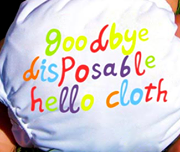Doctors’ Notes
BackCloth Diapers
When we decided — really I decided, then got Hubby onboard — to cloth diaper, our friends and family thought we were crazy. But cloth diapering isn’t what it used to be!
I spent hours reading and researching all the different kinds of diapers before my sweet little baby girl was born. I by no means consider myself an expert, but I encourage you to keep reading, and maybe you’ll think I’m not so crazy anymore.
To begin, let’s discuss the “why”…
Why Cloth Diapers?
I originally started looking into cloth diapers for two reasons:
1. Because I’m cheap (okay, maybe thrifty is a better word!)
2. Because I was having a hard time imagining all that waste just hanging out in a landfill somewhere.
In a household with one child in diapers, disposable diapers account for up to 50% of the household waste! And, though no one knows for sure, estimates say disposable diapers will take anywhere from 250-500 years to decompose!
With some help from my number crunching hubby, we broke it down diaper-for-diaper. For us, for our first child, we’re saving a few hundred dollars over the course of the expected 2 years in diapers. But the big savings come with the following child(ren), because then there are no “start-up” costs. We’re able to cloth-diaper baby #2 essentially for free. (Part of our cost is also because the type of diaper we have chosen, but I’ll get to that in a minute.)
If you’d like to know the breakdown, I’m sure he has a spread sheet somewhere and would be more than happy to share it with you. For the sake of this article, I’ll keep it simple!
Alright, now to the burning question…
How to Cloth Diaper?
There are a few types of cloth diapers out there and a multitude of brands. Let’s start easy and break them down into two categories:
PREFOLDS
This is a fancy name for your grandmother’s cloth diapers. Flat piece of fabric, thicker int he middle, fold onto baby and clip into place. (There are newer styles of closers, so you don’t need to use pins anymore.) This kind does require a waterproof outside/cover.
FITTED
These are shaped more like disposable diapers, with the absorbing material and the cover together. They can be broken down into three sub-categories:
- All-in-One
The absorbent part and the cover are together in one product. The absorbent part is either permanent or snapped into the cover.
Similar to the all-in-one, but the cover has a pocket to stuff a removable absorbent pad into. No built-in absorbency. The pocket is usually fleece, which allows moisture to wick away from the baby’s skin into the absorbent pad.
- Hybrid
I like to think of these as “hammock” diapers, because the absorbent pad is against the baby’s skin, sitting in a waterproof hammock. The “hammock” is attached to the cover. The beauty of hybrid diapers is that they can be used with reusable liners (absorbent pad) OR disposable liners.
*This is the one we chose- and we LOVE it! Our NAEYC daycare allows the disposable liners, and we use the reusable liners while we’re at home. Win-win! (Most daycares will not allow reusable diapers because of sanitary issues. NAEYC is very strict on this — but since they can throw away the inserts, they’re happy.) Our disposable liners are biodegradable and flushable too! Woo-hoo!
And now to the last two big questions…
Isn’t it Gross to Touch All That Poop?!
Let’s be real… Whether you’re using disposable or reusable diapers, changing poopy diapers is gross.
That said, here’s the routine we acquired through our learning process:
Breastfed baby poop is water-soluble and doesn’t need to be rinsed/soaked before washing. (Or so they say.) I still soaked. We put the liners in a bucket of water and nightly, or every other night, did a load of diapers. By the time it was wash time, we were able to dump the water, and all the grossness with it, down our toilet (And, hey: back into the sewage system is where poop is supposed to go — not into land fills soaking into our clean water source. But, anyway: back on topic…)
Once Sweet Baby Girl(s) was big enough and eating foods, the #2 could be dropped into the toilet and flushed away. We invested in a diaper sprayer — which attaches to the toilet and is very similar to a shower sprayer; it allows you to spray the poop down the potty.
Aren’t You Doing Laundry All the Time?!
Again, let’s be real… With a family that includes a toddler and an infant, I’m doing laundry all the time anyway. One extra load every few days that does not need to be folded (my least favorite — alright, most hated — part of laundry) truly doesn’t occupy that much extra time.
Now, this isn’t meant to be an all-inclusive look into cloth diapers; there are many other pros/cons I could discuss. I only hoped to provide a quick overview to get you thinking about your own diapering choices.
I love our decision to cloth diaper, and I’d absolutely choose it again given the chance. The few sacrifices we’ve made to cloth diaper — the extra load every few days, soaking the diapers, stuffing the diapers because we choose the hybrid — are absolutely worth it.
If you see me in the office I’d be more than happy to talk, share, and/or compare our experience. Or, if you have any further questions, just let me know; I have a plethora of websites I used when first researching, and I’d be happy to share at anytime.
See… I’m not so crazy right?!
Stacey Stratton is a member of the American Academy of Physician Assistants and the Society for Physician Assistants in Pediatrics.
